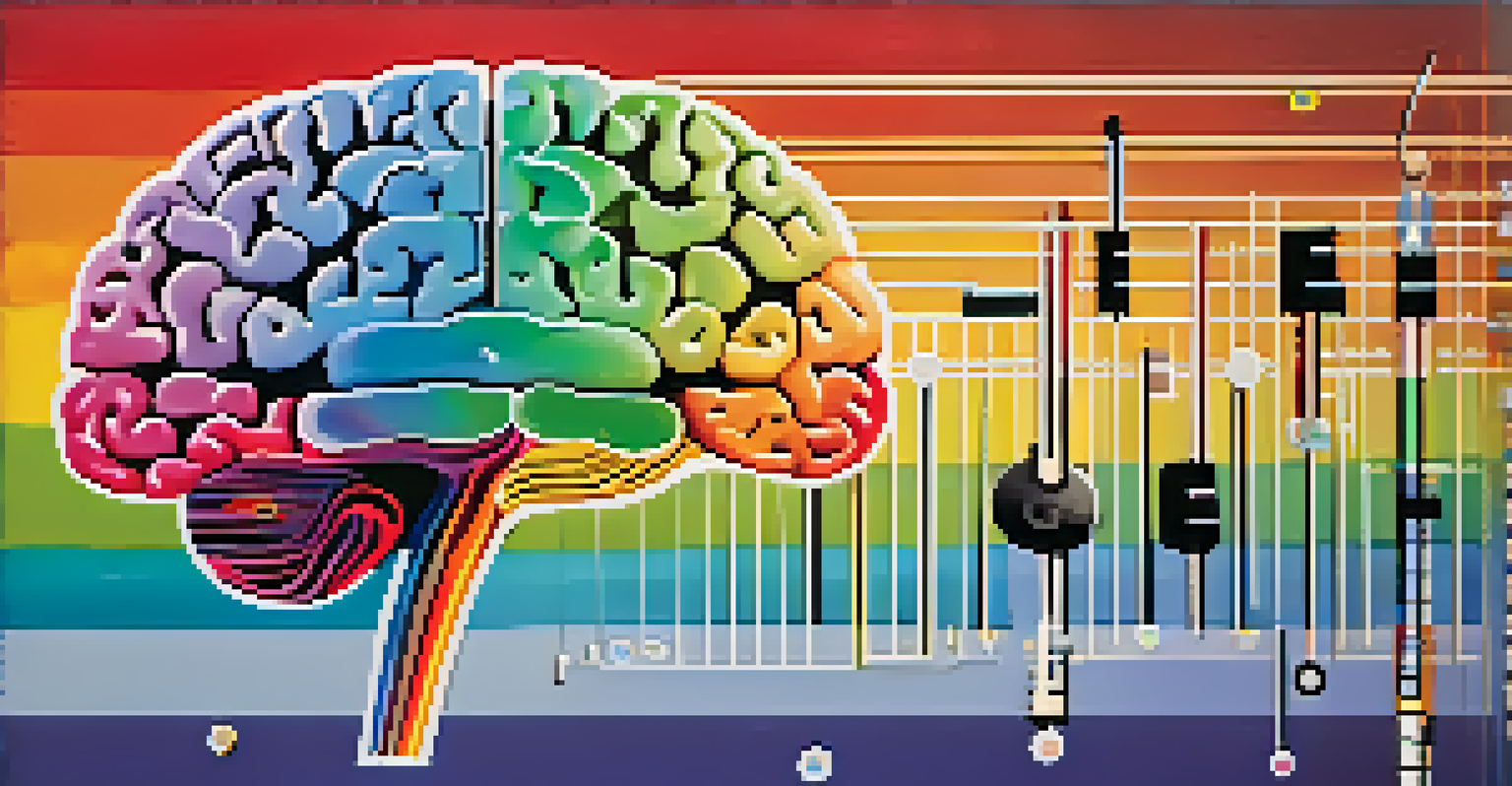Cognitive Processing of Language and Music: A Comparative Study

Understanding Cognitive Processing: Language vs. Music
Cognitive processing refers to how our brains interpret and understand information. When it comes to language and music, both are complex systems that require interpretation and comprehension. However, they engage different, yet overlapping, areas of the brain, showcasing the intricacies of our cognitive functions.
Music is the shorthand of emotion.
Language processing involves grammar, vocabulary, and context, while music processing includes rhythm, pitch, and melody. This duality illustrates how our brains are wired to decode these forms of communication. Understanding these processes can help us appreciate why some people excel in one area over the other.
Research shows that both language and music utilize similar neural pathways, particularly in the left hemisphere of the brain. This suggests that learning music can enhance language skills, making the study of their cognitive processing even more intriguing.
The Neuroscience Behind Language Processing
Language processing is primarily rooted in areas of the brain like Broca's and Wernicke's areas. Broca's area is responsible for speech production and language comprehension, while Wernicke's area focuses on understanding spoken and written language. These regions work together to enable fluent communication.

When we hear a sentence, our brains rapidly analyze its structure and meaning. This process involves not just recognizing words but also understanding context and emotions behind them. The complexity involved in language processing can sometimes lead to misunderstandings, showcasing how nuanced communication can be.
Language and Music: Shared Pathways
Both language and music processing engage similar neural pathways in the brain, suggesting that musical training can enhance language skills.
Neurological studies, including brain scans, reveal that language processing is a dynamic and fast-paced activity. Our brains continuously adjust and adapt as they encounter new linguistic structures, highlighting the incredible capacity for learning and adaptation in humans.
The Neuroscience Behind Music Processing
Similar to language, music processing engages specific areas of the brain, including the auditory cortex and the motor areas. The auditory cortex helps us perceive sound, while the motor areas are involved when we tap our feet to a beat or play an instrument. This interplay between different brain regions highlights how music is not just heard but also felt and experienced.
Language is the road map of a culture. It tells you where its people come from and where they are going.
When we listen to music, our brains decode various elements like rhythm, melody, and harmony. This involves a complex cognitive response that allows us to appreciate the emotional and aesthetic qualities of music. Just as with language, the context and cultural background can significantly influence our musical interpretation.
Interestingly, studies show that music can evoke powerful emotional responses, often more intense than those triggered by language. This emotional connection can enhance memory and learning, suggesting that music plays a vital role in cognitive development and emotional well-being.
Comparative Studies: Language and Music Processing
Comparative studies in cognitive processing have revealed fascinating similarities and differences between language and music. For instance, both require working memory, allowing us to hold information temporarily while we analyze and respond to it. This shared requirement suggests that our cognitive systems may be more interconnected than previously thought.
One key difference lies in how we perceive syntax in language versus music. In language, syntax dictates how words are arranged to convey meaning, while in music, it relates to the arrangement of notes and rhythms. These distinctions highlight the unique rules governing each system and how our brains navigate them differently.
Culture Shapes Communication Styles
Cultural differences influence how we process language and music, affecting phonetic structures and musical interpretations.
Moreover, research indicates that musicians often outperform non-musicians in language tasks, such as verbal memory and phonetic awareness. This correlation suggests that engaging with music can enhance language skills, bridging the gap between these two forms of communication.
The Role of Rhythm in Language and Music
Rhythm is a fundamental aspect of both language and music, shaping how we perceive and produce them. In language, rhythm helps us understand the flow of speech, emphasizing certain words and phrases. This rhythmic quality can influence how we interpret meaning and emotion in conversations.
In music, rhythm creates patterns that evoke emotional responses and drive movement. It's the heartbeat of a song, guiding us through its structure. Just as in language, a well-placed rhythm can significantly enhance the overall message, whether in a catchy tune or a poignant speech.
Interestingly, studies have shown that rhythm can aid language learning, particularly in young children. By tapping into the natural rhythm of speech, children can grasp language patterns more easily, demonstrating how deeply intertwined these two cognitive processes are.
The Impact of Culture on Language and Music Processing
Culture plays a significant role in shaping how we process both language and music. Different languages possess unique phonetic structures and syntactic rules, influencing how speakers comprehend and produce language. Similarly, cultural background affects musical preferences and interpretations, leading to diverse auditory experiences.
For instance, tonal languages like Mandarin require speakers to discern pitch variations that can change word meanings. This linguistic feature parallels certain musical traditions that emphasize pitch in their compositions. Such cultural nuances highlight the importance of context in both language and music processing.
Rhythm Enhances Learning and Emotion
Rhythm plays a crucial role in both language and music, aiding language learning and evoking emotional responses.
Moreover, exposure to different musical styles can enhance our linguistic abilities. Studies suggest that individuals who engage with diverse musical genres tend to develop more robust language skills, showcasing the profound impact of culture on cognitive processing.
Future Directions in Cognitive Processing Research
As our understanding of cognitive processing continues to evolve, researchers are increasingly focusing on the interplay between language and music. Future studies may explore how musical training can be integrated into language education, potentially enhancing literacy rates and communication skills.
Additionally, advancements in neuroimaging technologies allow for deeper insights into brain activities during language and music processing. This could lead to the development of new therapeutic approaches for individuals with language impairments or cognitive disorders, offering hope for improved communication.

Ultimately, exploring the cognitive processing of language and music not only enhances our understanding of these forms of communication but also enriches our appreciation of the human experience. As we uncover the connections between them, we may find innovative ways to foster learning and creativity across diverse fields.